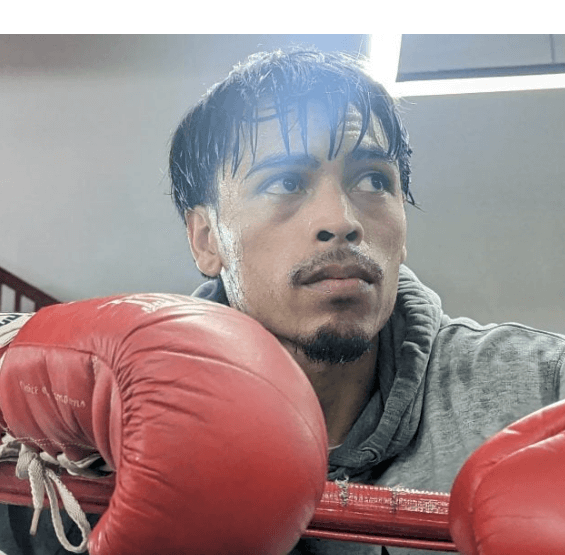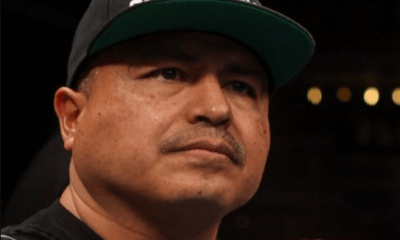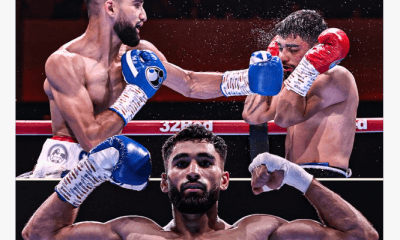Featured Articles
Angelo Leo’s Homecoming Fight in Albuquerque was Fermented on ProBox

“I always dreamed of this; I visualized it.” The speaker is Angelo Leo who had just finished sparring 14 rounds in the sweat-box that was the Bones Adams Gym. (It was 108 degrees, or thereabouts, outside its walls and it felt about the same inside the cozy gym.)
Leo’s dream was winning a world title in front of the home folks. He gets the chance to make the dream a reality on Aug. 10 when he opposes IBF world featherweight champion Luis Alberto “Venado” Lopez in Albuquerque, New Mexico, on a Top Rank/ESPN card at 11,500-seat Tingley Coliseum.
Angelo Leo became the fifth fighter from Albuquerque to win a world title following Bob Foster, Johnny Tapia, Danny Romero, and Holly Holm when he outpointed Tramaine Williams on Aug, 1, 2020 at Connecticut’s Mohegan Sun Casino to capture the vacant WBO 122-pound world title. His reign was brief. Five months later, he lost the belt to Philadelphia’s slick Stephen Fulton. That remains his only defeat in 25 pro bouts
Back in those days, Leo, who made his pro debut in Albuquerque at age 18, was a Mayweather Promotions fighter. He had a dozen fights under the Mayweather umbrella, seven of the first eight at Sam’s Town, an off-Strip joint in Las Vegas where he earned his spurs and had his first 10-round fights.
The Pandemic put a stop to those events and the Sam’s Town developmental series was never re-kindled. Mayweather Promotions is still a going concern, but the company no longer has a venue to keep up-and-comers active with the result that the roster of Mayweather fighters has been greatly reduced.
The Pandemic stalled Angelo’s career. He was inactive from June of 2021 until November of 2023. During this period his contract with Mayweather expired and he became a free agent.
He has had three fights since returning to the ring, defeating Nicolas Polanco (TKO 9), Mike Plania (TKO 3) and Eduardo Baez (UD 10). These fights were on ProBox cards in Florida.
The ProBox events – mid-week shows live-streamed for free with no strings attached (at least free for the time being) — are staged in the auditorium of an alcohol and drug rehabilitation facility in the Tampa suburb of Plant City. The setting is ironic as ProBox founder Garry Jonas, who owns the place, has shown a fondness for once-prominent boxers whose careers have stalled and are in need of rehabilitation.
The evolution of ProBox is now in a second phase. Jonas is now partnering with other promoters to get rich paydays for some of the fighters whose careers he has resurrected. In August, three ProBox alums have important assignments on consecutive Saturdays. On Aug. 3, Radivoje “Hot Rod” Kalajdzic, a former world title challenger, meets David Morrell in Los Angeles for the vacant WBA light heavyweight title. The next week it’s Leo vs. Lopez in Albuquerque and then, although it’s not yet official, Trevor McCumby meets former super middleweight title-holder Caleb Plant. On the shelf for four-and-a-half years, partly because of PED-related issues, McCumby returned to the ring in May of last year and fought most recently in Plant City.
Angelo Leo’s amateur career was going great guns when he and his trainer/manager father Miguel Leo pulled up stakes and moved to Los Angeles where there were more opportunities for a young boxer to mature in his craft. Angelo finished his high school years there at Fairfax High School in the polyglot Fairfax district. Las Vegas has been his primary residence since signing with Mayweather.
An interesting fact about Leo is that he has a Chinese strain in his family tree. It comes through his paternal great grandfather who immigrated to Mexico from China. Ask him his favorite boxer when he was growing up and a long list of names rolls off his tongue: Roberto Duran, Sugar Ray Leonard, Michael Carbajal, Danny Romero, Marco Antonio Barrera…He has watched many of their fights on tape over and over again.
As a pro, Leo has fought only twice in the city of his birth, most recently in 2015 when he appeared in a 6-rounder on a low-budget show at the Civic Center. Back then money was tight and he worked part time busing tables at the Frontier Restaurant, a local hangout where the signature dish is a breakfast burrito.
He won’t be busing any tables when he returns in August and makes his first ring appearance in Albuquerque in nine years with the newest member of his team, his 20-month-old son Aziel, looking on. And, although he will have the crowd in his corner, he will need to be at his best to unseat Mexicali’s “Venado” Lopez who will be making the fourth defense of his title and riding into New Mexico riding a 13-fight winning streak.
Lopez is accustomed to fighting in a hostile environment. He won the title in Leeds, England, outpointing local hero Josh Warrington and then, in his first defense, went to Belfast and massacred Michael Conlan. However, his opponents in his four title fights (Warrington, Conlan, Joet Gonzalez, and Reiya Abe) were hardly a murderers’ row and the first betting line to appear on this fight between the two 30-year-old scrappers was a head-scratcher. Lopez opened a 7 ½-1 (minus-750) favorite, a price that will inevitably nick down.
The cheers will be deafening when Angelo Leo makes his ringwalk on Aug. 10. And then, for he and his homies, comes the hard part, making his dream something more than a fantasy.
To comment on this story in the Fight Forum CLICK HERE
Photo credit: Alan Dawson / ProBox
-

 Featured Articles4 weeks ago
Featured Articles4 weeks agoResults and Recaps from New York Where Taylor Edged Serrano Once Again
-

 Featured Articles1 week ago
Featured Articles1 week agoThe Hauser Report: Zayas-Garcia, Pacquiao, Usyk, and the NYSAC
-

 Featured Articles3 days ago
Featured Articles3 days agoOscar Duarte and Regis Prograis Prevail on an Action-Packed Fight Card in Chicago
-

 Featured Articles3 weeks ago
Featured Articles3 weeks agoResults and Recaps from NYC where Hamzah Sheeraz was Spectacular
-

 Featured Articles4 weeks ago
Featured Articles4 weeks agoFrom a Sympathetic Figure to a Pariah: The Travails of Julio Cesar Chavez Jr
-

 Featured Articles2 weeks ago
Featured Articles2 weeks agoManny Pacquiao and Mario Barrios Fight to a Draw; Fundora stops Tim Tszyu
-

 Featured Articles4 weeks ago
Featured Articles4 weeks agoPhiladelphia Welterweight Gil Turner, a Phenom, Now Rests in an Unmarked Grave
-

 Featured Articles2 weeks ago
Featured Articles2 weeks agoArne’s Almanac: Pacquiao-Barrios Redux




















